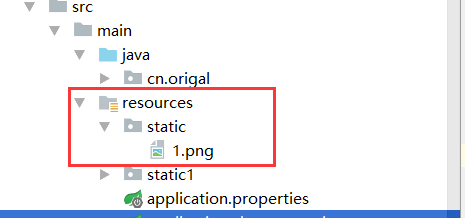springboot学习(六) springboot开发web应用
1、简介
Spring Boot非常适合开发web应用程序。你可以使用内嵌的Tomcat,Jetty或Undertow轻轻松松地创建一个HTTP服务器。大多数的web应用都使用spring-boot-starter-web模块进行快速搭建和运行。
2、静态资源的访问
(1)默认情况
Spring Boot从classpath下一个叫/static(/public,/resources或/META-INF/resources)的文件夹或从ServletContext根目录提供静态内容。这使用了Spring MVC的ResourceHttpRequestHandler,所以你可以通过添加自己的WebMvcConfigurerAdapter并覆写addResourceHandlers方法来改变这个行为(加载静态文件)。
默认例子:我们在resources目录下创建一个目录叫做static,然后将1张名为1.png图片拷贝到该目录下,启动程序后,直接通过http://localhost:8080/1.png访问,就可以看到该张图片。

(2)静态资源的映射
spring boot默认将/**形式的请求映射到/static(/public,/resources或/META-INF/resources)目录,所以默认情况下我们访问静态资源的时候不需要添加目录static,如果想要改变请求的映射,那么在配置文件中添加:
1 spring.mvc.static-path-pattern=/static/**
添加过后,如果想要访问上面的静态资源,则需要通过http://localhost:8080/static/1.png请求才可以。
(3)自定义静态文件目录
如果需要重新定义静态文件访问的目录,则可以在配置文件中添加:
1 spring.resources.static-locations=classpath:/static1/,classpath:/static2/,file:E:/image/
添加完成后,静态资源目录就会被重新定向到上面的那些文件夹下面,而不再是默认的文件夹。
- 静态可以目录可以定义多个,不同的目录之间用","隔开
- 使用classpath: 为前缀指向的是相对目录
- 使用file: 为前缀指定的是绝对目录
(4)静态文件缓存
在配置文件中配置使用静态文件缓存,并且在请求url中添加上版本号,那么在修改静态文件过后,就可以直接看到最新的静态文件:
1 # 对静态文件进行缓存处理 2 spring.resources.chain.strategy.content.enabled=true 3 spring.resources.chain.strategy.content.paths=/** 4 # 对静态文件添加版本,修改文件后,不需要改文件名就可以直接看到修改过后的内容 5 spring.resources.chain.strategy.fixed.enabled=true 6 spring.resources.chain.strategy.fixed.paths=/** 7 spring.resources.chain.strategy.fixed.version=1.0.0
请求地址:http://localhost:8080/1.jpg?v=1.0.0
说明:如果想要把项目作为一个jar包的形式运行,那么就不要使用src/main/webapp目录,因为这个目录只会在war包下使用。
3、web模板引擎
spring boot为freemaker, groovy, thymeleaf, mustache提供自动配置支持。可能的话,尽量使用上面的这些模板引擎,并且尽可能的不要使用jsp,因为内置的servlet容器使用他们时,无法完全使用spring boot的某些特性。
当使用上面这些模板时,会自动从src/main/resources/templates目录下读取相应的模板。
如果想用thymeleaf引擎,那么在pom中引入依赖:
<dependency>
<groupId>org.springframework.boot</groupId>
<artifactId>spring-boot-starter-thymeleaf</artifactId>
</dependency>
thymeleaf模板引擎的默认配置为:
1 # Enable template caching. 2 spring.thymeleaf.cache=true 3 # Check that the templates location exists. 4 spring.thymeleaf.check-template-location=true 5 # Content-Type value. 6 spring.thymeleaf.content-type=text/html 7 # Enable MVC Thymeleaf view resolution. 8 spring.thymeleaf.enabled=true 9 # Template encoding. 10 spring.thymeleaf.encoding=UTF-8 11 # Comma-separated list of view names that should be excluded from resolution. 12 spring.thymeleaf.excluded-view-names= 13 # Template mode to be applied to templates. See also StandardTemplateModeHandlers. 14 spring.thymeleaf.mode=HTML5 15 # Prefix that gets prepended to view names when building a URL. 16 spring.thymeleaf.prefix=classpath:/templates/ 17 # Suffix that gets appended to view names when building a URL. 18 spring.thymeleaf.suffix=.html spring.thymeleaf.template-resolver-order= # Order of the template resolver in the chain. spring.thymeleaf.view-names= # Comma-separated list of view names that can be resolved.
需要调整,则将对应的拷贝到配置文件中,进行修改即可。



